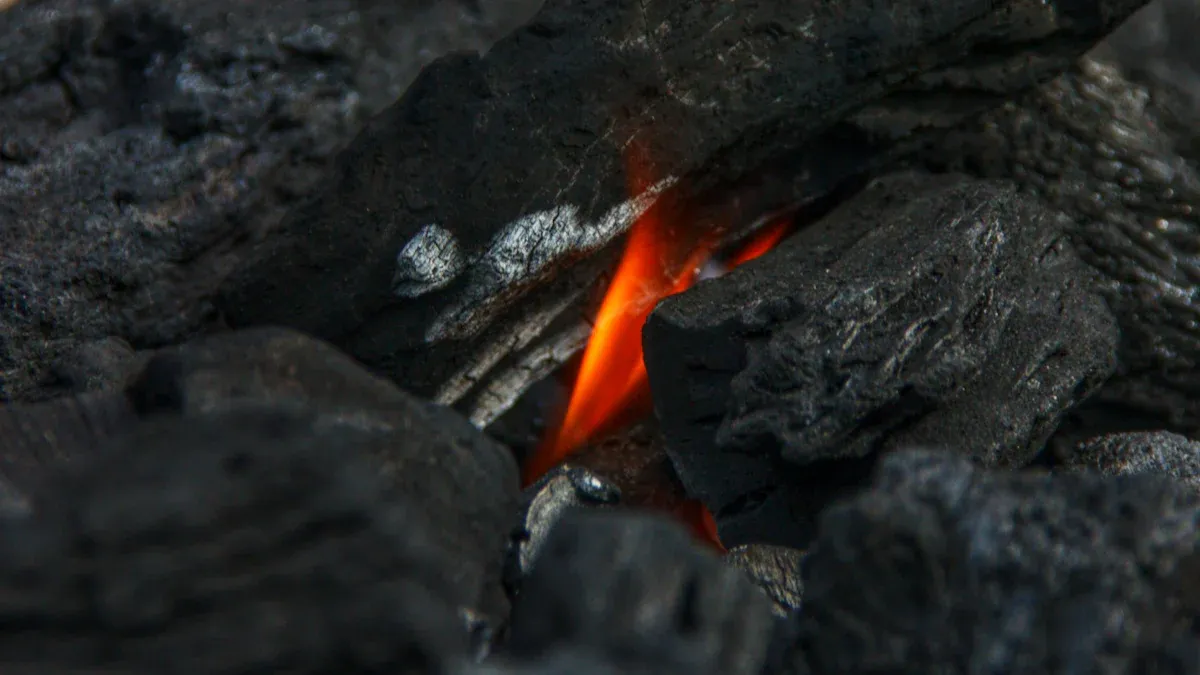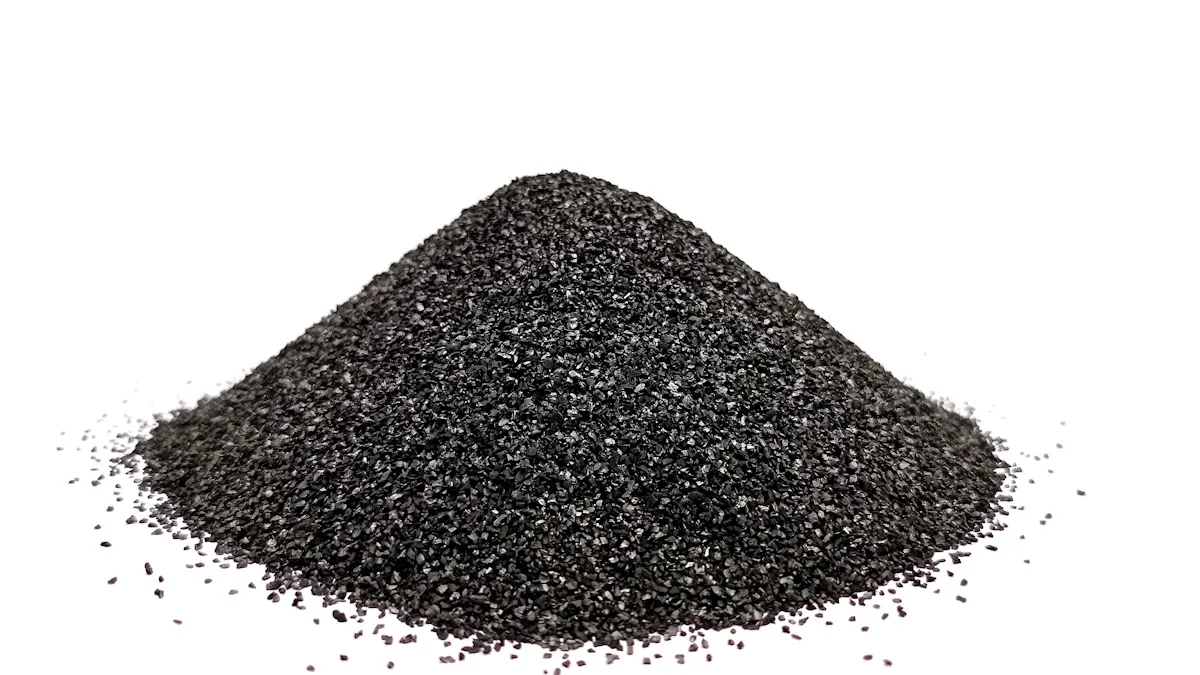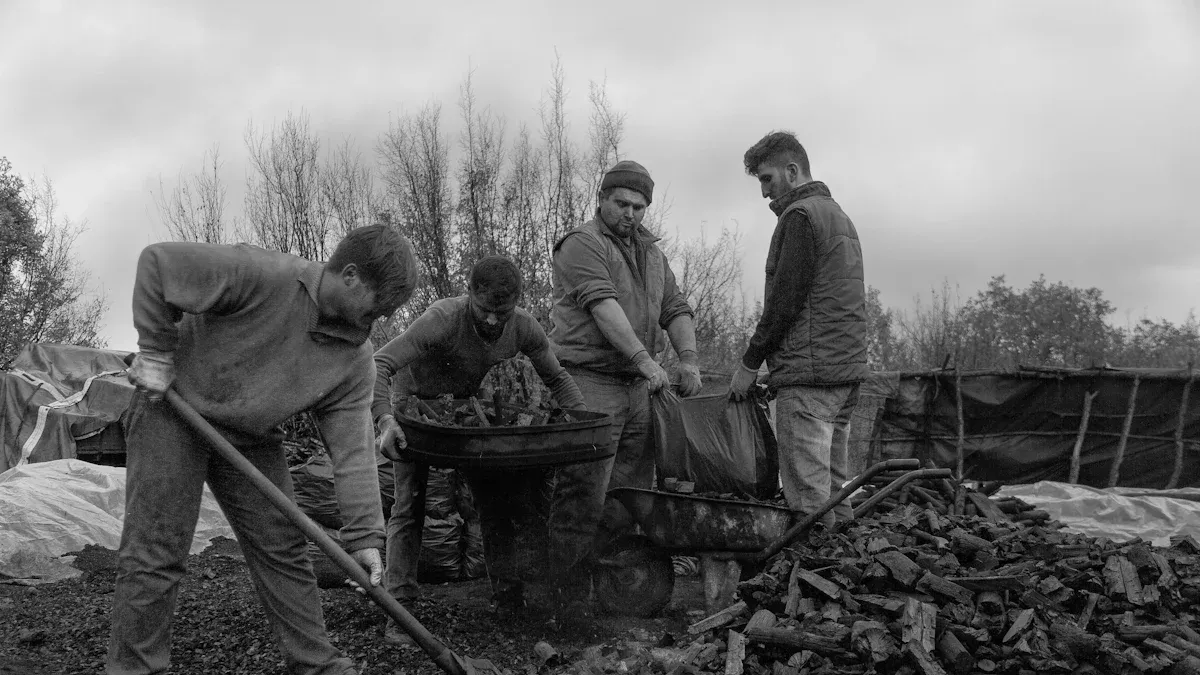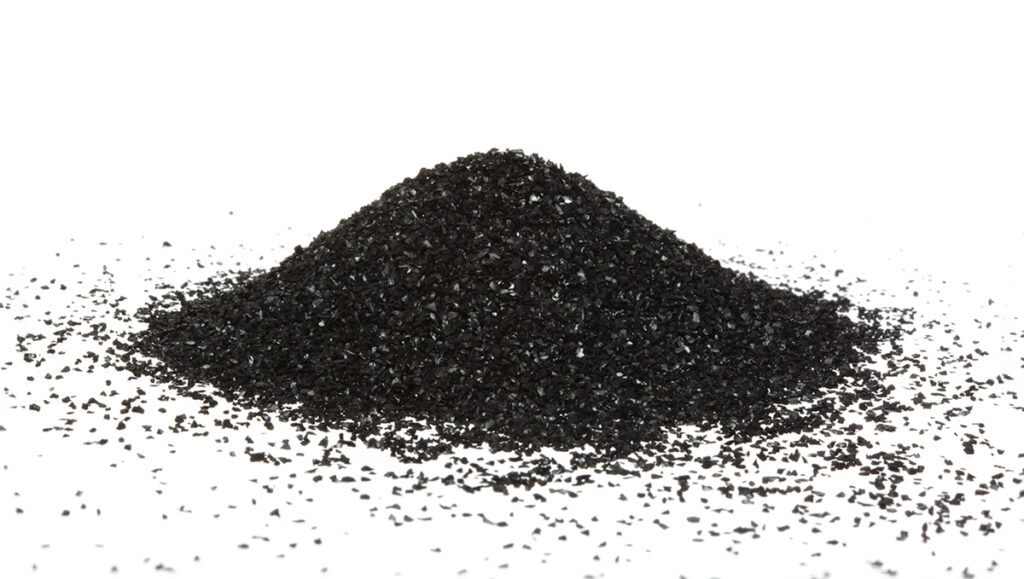
You use powdered activated carbon when you need a material with tiny particles and a very large surface area. These small particles, usually less than 0.18 mm, help capture impurities quickly. The production process involves activating organic materials, which gives this carbon its unique adsorption ability.
| Type of Activated Carbon | Particle Size Range | Surface Area Characteristics |
|---|---|---|
| Powdered Activated Carbon (PAC) | Less than 0.18 mm | High surface area, rapid adsorption |
| Granular Activated Carbon (GAC) | 0.2 to 5 mm | Good balance between adsorption and flow rate |
| Extruded Activated Carbon (EAC) | 1 mm or larger | Lower surface area per gram |
Key Takeaways
- Powdered activated carbon (PAC) has tiny particles and a large surface area, making it effective for quickly capturing impurities in water and air.
- The production of PAC involves activating organic materials like coal or coconut shells, which enhances its adsorption capabilities.
- PAC is ideal for emergency water treatment due to its rapid adsorption of contaminants, including organic compounds and pesticides.
- Unlike granular activated carbon, PAC cannot be reused and requires frequent replacement, but it offers flexibility and fast results.
- PAC is used in various industries, including water treatment, air purification, and food processing, providing reliable filtration solutions.
What is Powdered Activated Carbon

Definition
You find powdered activated carbon in the form of a fine powder or tiny granules. Most particles measure less than 1.0 mm in diameter, and you usually see sizes between 0.15 mm and 0.25 mm. This small size helps the carbon mix easily with liquids and reach impurities quickly.
- Powdered activated carbon works best when you need fast adsorption.
- You often use it in water treatment because it can trap many types of contaminants.
- The fine particles give you a large surface area, which means more places for molecules to stick.
Tip: If you want to remove unwanted chemicals from water or air, powdered activated carbon gives you a quick and effective solution.
Key Properties
You notice several important features when you use powdered activated carbon. These properties set it apart from other adsorbents and make it useful in many applications.
| Property | Description |
|---|---|
| Particle Size | Small particle size enhances adsorption efficiency for small molecules. |
| Surface Area | Ranges from 500 to 2000 m² per gram, providing numerous active sites. |
| Pore Size Distribution | Composed of micropores, mesopores, and macropores for varied adsorption. |
| Adsorption Capability | Effective for small, polar or non-polar molecules, especially in water treatment. |
You get a huge surface area, sometimes up to 2000 square meters per gram. This means you have many active sites for trapping impurities. The pores in powdered activated carbon come in three main sizes:
- Micropores (less than 2 nanometers): These help you capture small molecules like gases.
- Mesopores (2 to 50 nanometers): These work well for larger organic molecules.
- Macropores (greater than 50 nanometers): These act as channels for moving molecules into the carbon.
The mix of pore sizes lets you remove a wide range of contaminants. You can target both tiny and larger molecules, making powdered activated carbon a flexible choice for cleaning water and air.
Powdered Activated Carbon: Production

Raw Materials
You start with organic materials when you make powdered activated carbon. These materials give you the base for activation. You often use coal, wood, coconut shells, and lignite. Each type brings different properties to the final product.
| Raw Material |
|---|
| Coal |
| Wood |
| Coconut Shells |
| Lignite |
You can also create powdered activated carbon by grinding granular activated carbon or collecting fines from other production processes. This method helps you use leftover materials and reduce waste.
Note: The way you source raw materials affects the environment. If you choose coconut shells or wood waste, you help lower the carbon footprint. Using agricultural waste supports sustainability and helps build a circular economy.
Physical Activation
You use physical activation to turn raw materials into powdered activated carbon. This process has two main steps: carbonization and activation.
| Step | Description |
|---|---|
| Carbonization | You heat the material to form a char. |
| Activation | You expose the char to steam or carbon dioxide at high temperatures (900–1200°C). This step enlarges pores and increases surface area. |
You begin with carbonization. You heat the raw material in an inert atmosphere, usually nitrogen, at up to 500 °C. You set the heating rate at 3 °C per minute and hold the temperature for 2 hours. This step removes volatile substances and leaves you with a carbon-rich char.
- You use nitrogen as the inert gas during carbonization.
- You follow with activation, where you treat the char with steam or carbon dioxide.
- You raise the temperature to between 900 °C and 1200 °C.
- You use a gas stream to help open up the pores in the carbon.
Physical activation gives you powdered activated carbon with a large surface area and many pores. You can control the pore structure by adjusting the temperature and gas flow.
Chemical Activation
You can also make powdered activated carbon using chemical activation. You mix the raw material with chemicals before heating. This method lets you create a product with different pore sizes and surface areas.
| Chemical | Description |
|---|---|
| ZnCl2 | Zinc chloride |
| NaOH | Sodium hydroxide |
| H3PO4 | Phosphoric acid |
| KOH | Potassium hydroxide |
| Na2CO3 | Sodium carbonate |
| H2SO4 | Sulfuric acid |
| HNO3 | Nitric acid |
You choose a chemical like zinc chloride, phosphoric acid, or potassium hydroxide. You mix it with the raw material and heat it to activate the carbon. The chemical helps open up the pores and increases the surface area. You wash the final product to remove any leftover chemicals.
Tip: Chemical activation often uses lower temperatures than physical activation. You get a different pore structure, which can help you target specific contaminants.
Powdered activated carbon made by chemical activation can be tailored for special uses. You select the chemical and process to match your needs.
Comparison with Other Activated Carbons
Granular vs. Powdered
You often choose between granular activated carbon (GAC) and powdered activated carbon (PAC) based on your needs. The main differences come from particle size, surface area, and how you use them.
| Type of Activated Carbon | Particle Size | Surface Area | Pros | Cons |
|---|---|---|---|---|
| Powdered Activated Carbon (PAC) | Less than 0.18 mm | High surface area | Rapid adsorption | Requires frequent replacement |
| Granular Activated Carbon (GAC) | 0.2 to 5 mm | Moderate surface area | Good balance between adsorption and flow rate | Slightly lower adsorption rate compared to PAC |
You see that PAC has much smaller particles than GAC. This gives you a higher surface area, which means PAC can adsorb impurities faster. GAC works well when you need a steady, long-term solution. You often find GAC in municipal water plants and industrial systems. PAC fits best when you need a quick fix, such as during a sudden contamination event.
When you look at performance, GAC removes heavy metals and supports biological activity better. PAC works well for removing pharmaceuticals and organic chemicals, but you need to use it in higher doses for some contaminants like PFAS. Handling also differs. GAC is easier to manage because it creates less dust. PAC needs careful handling and protective equipment to keep you safe from dust exposure.
Unique Advantages
You get unique benefits when you use powdered activated carbon. Its fine particle size lets you mix it easily with water or other liquids. This means you can quickly treat large volumes during emergencies or seasonal spikes in contamination.
- You can use PAC in water treatment, air purification, and food processing.
- You do not need to install permanent equipment for PAC. You can add it directly to the process and remove it after treatment.
- PAC gives you flexibility. You can adjust the dose based on the level of contamination.
- You get rapid results because PAC acts fast due to its high surface area.
Note: PAC cannot be regenerated for reuse. You need to replace it after each use, but you gain speed and flexibility in return.
Powdered activated carbon stands out when you need a fast, adaptable solution for removing a wide range of contaminants.
Uses of Powdered Activated Carbon
Water Treatment
You rely on powdered activated carbon to clean water quickly and effectively. Its porous structure traps many types of impurities. When you add it to water, it adsorbs contaminants that can affect taste, odor, and safety. You often use it in municipal water plants, emergency spill responses, and home filtration systems.
- Organic compounds
- Pesticides such as atrazine, simazine, and alachlor
- Industrial solvents like benzene and toluene
- Pharmaceuticals and hormones
- Natural organic matter that leads to disinfection by-products
- Color from tannins and lignins
- Algal toxins such as microcystin
- Taste and odor compounds like geosmin and MIB
You see that powdered activated carbon works well for removing both chemical and biological contaminants. Its fast action makes it ideal for treating sudden pollution events.
Air and Gas Purification
You use powdered activated carbon to improve air quality in many settings. It captures airborne pollutants and helps meet environmental standards. You find it in industrial plants, air filters, and biogas purification systems.
| Application Area | Description |
|---|---|
| Industrial Waste Gas Treatment | You treat emissions from factories to reduce harmful gases and improve air quality. |
| Air Purification Systems | You filter and capture airborne contaminants in homes, offices, and hospitals. |
| Biogas Purification | You remove toxic gases like hydrogen sulfide and siloxanes from biogas to make it safer to use. |
You notice that powdered activated carbon acts as a powerful adsorbent for many airborne contaminants. It plays a key role in keeping the air clean and safe.
Other Applications
You find powdered activated carbon in food and pharmaceutical industries. It helps you purify products and remove unwanted substances.
| Application Area | Role of PAC in Food Industry |
|---|---|
| Sugar Production | You remove color bodies and chemical residues without changing taste. |
| Edible Oils | You deodorize and purify oils for better quality. |
| Juices | You enhance clarity and remove odors. |
| Alcoholic Beverages | You purify and decolorize drinks to improve quality. |
You also use it to adsorb poisons, purify therapeutic additives, recover solvents, and support dialysis processes. In pharmaceutical manufacturing, you rely on powdered activated carbon to remove by-products and organic impurities from active ingredients. You use it in filtration systems and final polishing steps to ensure products are pure and safe.
Powdered activated carbon gives you a fast and effective way to remove impurities from water and air. You start with high-quality raw materials, then use physical or chemical activation to create a fine powder with a huge surface area.
- You benefit from rapid adsorption, flexible dosing, and strong performance in water treatment, air purification, and industrial processes.
- Environmental and economic advantages make it a smart choice for many industries.
You can trust powdered activated carbon for reliable, efficient filtration in today’s world.
FAQ
What is the difference between powdered and granular activated carbon?
You see powdered activated carbon as a fine powder. Granular activated carbon has larger particles. Powdered carbon works faster for short-term treatment. Granular carbon lasts longer and suits continuous filtration.
Can you reuse powdered activated carbon?
You cannot reuse powdered activated carbon. You must replace it after each use. The fine particles make regeneration difficult. You get fast results, but you need fresh carbon for every treatment.
Is powdered activated carbon safe for drinking water?
You can use powdered activated carbon in drinking water treatment. It removes many contaminants. Water plants use it to improve taste and safety. You must follow recommended doses to keep water safe.
How do you store powdered activated carbon?
You should keep powdered activated carbon in a dry, sealed container. Moisture reduces its effectiveness. Store it away from heat and chemicals. Use gloves and a mask when handling the powder.
What contaminants does powdered activated carbon remove?
You can remove organic chemicals, pesticides, odors, and some heavy metals. Powdered activated carbon works well for pharmaceuticals and industrial pollutants. Its large surface area helps trap many types of impurities.

